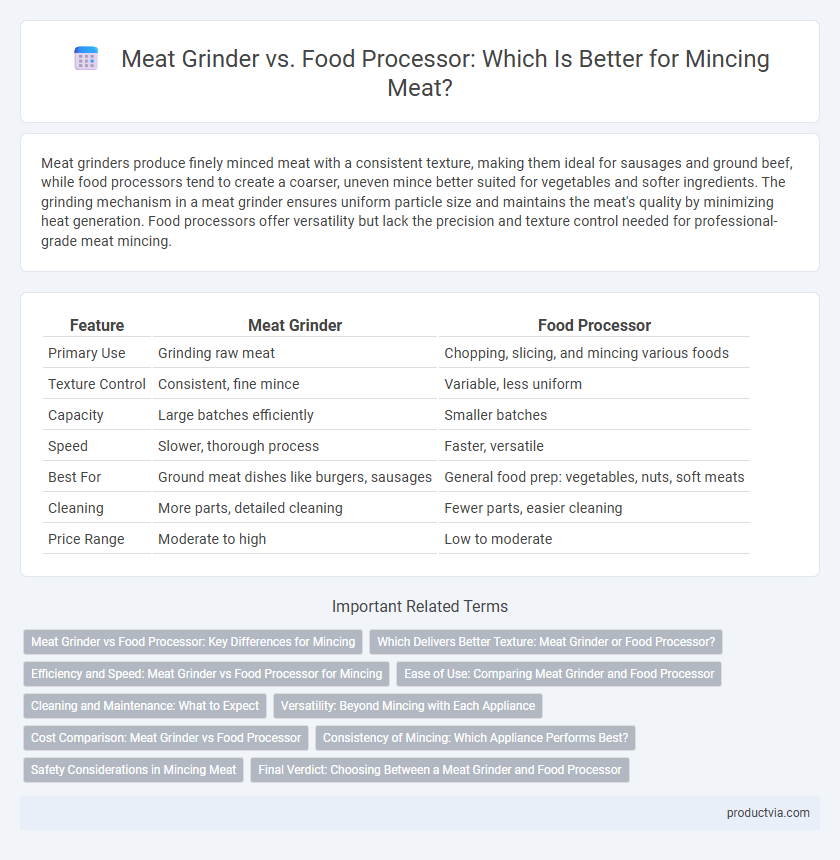Meat grinders produce finely minced meat with a consistent texture, making them ideal for sausages and ground beef, while food processors tend to create a coarser, uneven mince better suited for vegetables and softer ingredients. The grinding mechanism in a meat grinder ensures uniform particle size and maintains the meat's quality by minimizing heat generation. Food processors offer versatility but lack the precision and texture control needed for professional-grade meat mincing.
Table of Comparison
| Feature | Meat Grinder | Food Processor |
|---|---|---|
| Primary Use | Grinding raw meat | Chopping, slicing, and mincing various foods |
| Texture Control | Consistent, fine mince | Variable, less uniform |
| Capacity | Large batches efficiently | Smaller batches |
| Speed | Slower, thorough process | Faster, versatile |
| Best For | Ground meat dishes like burgers, sausages | General food prep: vegetables, nuts, soft meats |
| Cleaning | More parts, detailed cleaning | Fewer parts, easier cleaning |
| Price Range | Moderate to high | Low to moderate |
Meat Grinder vs Food Processor: Key Differences for Mincing
A meat grinder is specifically designed to handle tougher cuts of raw meat, producing a consistent, coarse or fine grind ideal for sausages and burgers. In contrast, a food processor offers versatility by chopping, slicing, and pureeing various ingredients but often delivers a less uniform mince due to its blade spinning motion. For precision in texture and handling dense meats, meat grinders typically outperform food processors in mincing quality and consistency.
Which Delivers Better Texture: Meat Grinder or Food Processor?
A meat grinder delivers better texture for mincing because its grinding plates create consistent, uniform cuts, preserving the integrity of the meat fibers. Food processors tend to pulverize ingredients, resulting in a less distinct texture that can be mushy or uneven. Precision in texture control makes meat grinders the preferred choice for recipes requiring finely minced yet textured meat.
Efficiency and Speed: Meat Grinder vs Food Processor for Mincing
Meat grinders deliver superior efficiency and speed when mincing large quantities of meat due to their powerful motors and specialized blades designed for consistent texture. Food processors offer versatility but often require multiple batches and manual scraping, which slows the minching process and can result in uneven cuts. For high-volume or uniform mincing tasks, a dedicated meat grinder maximizes productivity and achieves optimal texture.
Ease of Use: Comparing Meat Grinder and Food Processor
Meat grinders offer straightforward operation with simple controls and stable grips, ensuring consistent mincing results with less hands-on time. Food processors provide versatile functionality but often require careful assembly and pulse-button control to avoid over-processing meat. For users prioritizing ease of use and uniform meat texture, meat grinders are typically more user-friendly than food processors.
Cleaning and Maintenance: What to Expect
Meat grinders generally require more thorough cleaning because of their multiple parts like grinding plates and blades that trap meat residue, demanding careful disassembly and hand washing to prevent contamination. Food processors feature easier cleaning with dishwasher-safe components and fewer nooks, reducing time and effort in maintenance. Proper cleaning of both appliances is essential to avoid bacterial growth and ensure longevity, but meat grinders typically call for more frequent and detailed upkeep.
Versatility: Beyond Mincing with Each Appliance
Meat grinders excel in producing uniformly minced meat with precise control over texture, making them ideal for sausage making and ground beef preparations, while food processors offer broader versatility, capable of chopping, slicing, pureeing, and mixing various ingredients beyond just mincing. The ability of food processors to handle dough, nuts, and vegetables makes them indispensable for diverse culinary tasks, whereas meat grinders specialize in achieving consistent meat textures essential for traditional recipes. Choosing between the two depends on whether the user prioritizes specialized meat preparation or multifunctional kitchen capabilities.
Cost Comparison: Meat Grinder vs Food Processor
Meat grinders typically cost between $50 and $300, offering specialized mincing performance with durable stainless steel components ideal for frequent use. Food processors range from $70 to $250, providing multifunctionality beyond mincing but sometimes lacking the precision and texture consistency of dedicated meat grinders. Choosing between the two depends on budget priorities and whether versatility or optimal mincing quality is more important.
Consistency of Mincing: Which Appliance Performs Best?
Meat grinders deliver superior consistency for mincing by using a fixed blade and plate system that ensures even particle size, ideal for ground meat and sausages. Food processors tend to produce uneven textures due to their chopping action, making them less precise for uniform mincing. For recipes demanding consistent texture and fine mincing, meat grinders outperform food processors in achieving reliable results.
Safety Considerations in Mincing Meat
Meat grinders are specifically designed for mincing meat, ensuring safer handling and reducing the risk of contamination compared to food processors. Food processors can struggle with uneven grinding and may pose a higher chance of cross-contamination if not cleaned thoroughly. Choosing a meat grinder enhances safety by maintaining consistent texture and minimizing exposure to harmful bacteria during meat preparation.
Final Verdict: Choosing Between a Meat Grinder and Food Processor
A meat grinder offers superior texture control and consistency for mincing meat, producing uniform results ideal for recipes like sausages or burgers. Food processors provide versatility by handling various ingredients beyond meat but often create less precise mince with varying texture due to blade design. Selecting between a meat grinder and food processor depends on prioritizing specialized meat processing versus multifunctional kitchen use.
Meat grinder vs Food processor for mincing Infographic

 productvia.com
productvia.com